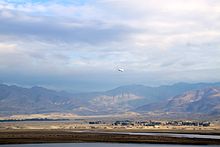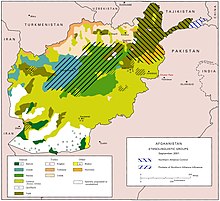Nangarhar Province
Nangarhar Province
ننگرهار | |
|---|---|
UTC+4:30 (Afghanistan Time) | |
| Postal code | 26XX |
| ISO 3166 code | AF-NAN |
| Main languages | Pashto, Dari |
Nangarhār (Pashto: ننګرهار; Dari: ننگرهار), also called Nangrahar or Ningrahar, is one of the 34 provinces of Afghanistan, located in the eastern part of the country and bordering Logar, Kabul, Laghman and Kunar provinces as well as having an international border with Pakistan. It is divided into 22 districts and has a population of about 1,735,531,[3] the third highest of the country's 34 provinces. The city of Jalalabad is the capital of Nangarhar province. Nangarhar province is famous for its fish and karahi dishes.[4]
Etymology
History
| History of Afghanistan | |
|---|---|
 | |
| Timeline | |
| 410–557 | |
| Nezak Huns | 484–711 |
Early history
This section needs additional citations for verification. (April 2015) |
The province was originally part of the Achaemenid Empire, in the Gandhara satrapy (province). The people in the area were originally Hindus and Buddhists. The Nangarhar province territory and the Eastern Iranian peoples there fell to the Maurya Empire, which was led by Chandragupta Maurya. Seleucus is said to have reached a peace treaty with Chandragupta by giving control of the territory south of the Hindu Kush to the Mauryas upon intermarriage and 500 elephants.
The region fell to the
During the
The province remained relatively calm until the 1980s
Recent history
This section needs additional citations for verification. (July 2020) |

Osama bin Laden held a strong position in Nangarhar during the late 1990s. He led a fight against US-led forces in the 2001 Tora Bora campaign. He ultimately escaped to Abbottabad, Pakistan, where he was killed in a night raid by members of SEAL Team Six in 2011.
After the removal of the
On 13 April 2017, U.S. President
Healthcare
The percentage of households with clean drinking water fell from 43% in 2005 to 8% in 2011.[12] The percentage of births attended to by a skilled birth attendant increased from 22% in 2005 to 60% in 2011.[12]
Education
Nangarhar University is located in the provincial capital, Jalalabad. It is government-funded and provides higher education to nearly 6,000 students from the region.
A number of schools operate in the province, providing basic education to both boys and girls. The overall literacy rate (6+ years of age) increased from 29% in 2005 to 31% in 2011.[12] The overall net enrollment rate (6–13 years of age) increased from 39% in 2005 to 51% in 2011.[12]
Economy
The Jalalabad plain is one of the principal agricultural areas of Afghanistan. The strong agricultural base, coupled with the crucial trade route connecting Kabul with Peshawar, makes Nangarhar one of the more economically diverse and functional provinces of Afghanistan.
Nangarhar is famous in Afghanistan for producing
Transportation
The Jalalabad Airport is located next to the city of Jalalabad. It serves the populations of Nangarhar, Kunar, Nuristan, and other nearby provinces.
The Kabul–Jalalabad Road runs throughout the province, linking Kabul with Jalalabad and extending east through Khyber Pass to Peshawar. It is one of the busiest major roads in Afghanistan.
Geography
This section needs expansion. You can help by adding to it. (October 2014) |

Demographics
This article is missing information about area of districts. (July 2020) |


As of 2021, the population of the province is around 1,735,531.[3] Over 90% of the population is Pashtun and the remaining is made up of Pashais, Tajiks, Arabs, and other ethnic groups.[17] The 18th edition Ethnologue states on p. 48 that Nangarhar is the center of the (smaller) Northern Pashto language in Afghanistan. Only 1 in 5 Afghan Pashtuns use the Northern variety.
Districts
Nangarhar is divided into 22 districts. They are as follows:
| District | Capital | Population[3] | Area[18] | Pop. density |
Notes |
|---|---|---|---|---|---|
Jalalabad |
Jalalabad | 271,867 | 122 | 2,228 | 85% Pashtun, 9% Hazara, 6% Pashai and other.[19] |
| Haska Meyna/Deh Bala | Haska Meyna | 45,570 | 337 | 135 | 100% Pashtun.[20] |
| Shinwar | Shinwar | 67,758 | 133 | 508 | 100% Pashtun.[21] |
| Achin | Achin | 113,328 | 466 | 243 | 100% Pashtun.[22] Includes the Spin Ghar District. |
| Bihsud | Bishud | 128,474 | 265 | 485 | 95% Pashtun (55% Jalalabad District .
|
| Chaparhar | Chaparhar | 68,156 | 277 | 246 | 100% Pashtun.[24] |
| Darai Nur | Darai Nur | 45,571 | 253 | 180 | 99% Pashai, 1% Pashtun.[25] |
| Bati Kot | Bati Kot | 85,562 | 195 | 438 | 100% Pashtun.[26] |
| Dur Baba | Dur Baba | 26,306 | 302 | 87 | 100% Pashtun.[27] |
| Goshta | Goshta | 30,823 | 523 | 59 | 100% Pashtun.[28] |
Hisarak |
Hisarak | 34,809 | 620 | 56 | 100% Pashtun.[29] |
| Kama | Kama | 86,890 | 229 | 380 | 97% Pashtun, 2% Uzbek, 1% Hazara.[30] |
Khogyani |
Kaga | 147,745 | 789 | 187 | 100% Pashtun.[31] |
| Kot | Kot | 58,857 | 188 | 313 | 99% Pashtun, 1% Tajik.[32] Created in 2005 within Rodat District |
| Kuz Kunar | Kuz Kunar | 62,178 | 298 | 209 | 75% Pashtun, 25% Pashai and others.[33] |
| Lal Pur | Lal Pur | 23,117 | 475 | 49 | 100% Pashtun.[34] |
| Momand Dara | Momand Dara | 50,752 | 240 | 211 | 100% Pashtun.[35] |
| Nazyan | Nayzan | 16,607 | 188 | 88 | 100% Pashtun.[36] |
| Pachir Aw Agam | 48,095 | 516 | 93 | 100% Pashtun.[37] | |
| Rodat | 78,121 | 272 | 287 | 100% Pashtun.[38] Sub-divided in 2005 | |
| Sherzad | 74,932 | 480 | 156 | 100% Pashtun.[39] | |
Surkh Rod |
136,180 | 312 | 437 | 88% Pashtun, 5% Hazara, 7% Pashai, Hindu and others.[40] | |
| Nangarhar | 1,701,698 | 7,641 | 223 | 92.5% Pashtuns (89.5% Pashtun tribes, 3.0% Pashtunized Arabs), 4.8% Pashayi, 2.3% Hazaras, 0.3% Hindus, 0.1% Uzbeks, <0.1% Tajiks.[note 1] |
- ^ Note: "Predominantely" or "dominated" is interpreted as 99%, "majority" as 70%, "mixed" as 1/(number of ethnicities), "minority" as 30% and "few" or "some" as 1%.
Sports

The province is represented in domestic
De Spinghar Bazan is a regional team in the Roshan Afghan Premier League based in Jalalabad. Jalalabad Regional Football Tournament were four local team plays like Malang Jan, Shaheed Qasim, Afghan Refugees and Laghman for to find raw talent in Afghan Premier League.[41] Wrestling in Jalalabad was modernized by Davud Sulaymankhil, a Pashtun orator and athlete. Now, several wrestling teams (most notably the Suleim Wrestling Team founded by Davud Sulaymanhil) represent the province in national events.
Stadiums
- Ghazi Amanullah International Cricket Stadium is the first international standard cricket stadium in Afghanistan. It is located in the Ghazi Amanullah Town about 15 kilometres south-east of Jalalabad.[42]
- Sirajul Emarah Football Stadium in Jalalabad[citation needed]
Notable people
Former Prime Minister of Afghanistan
- Muqadasa Ahmadzai - social and political activist
- Rashid Khan - Afghan Cricketer and winner of ICC Mens T20 Cricketer of Decade
- Hamid Hassan - Afghan Cricketer
- Qais Ahmad - Afghan Cricketer
- Aftab Alam - Afghan Cricketer
- Samiullah Shinwari - Afghan Cricketer
- Mohammad Shahzad - Afghan Cricketer
See also
References
- ^ "Taliban appoint new leaders of two provinces in Eastern Afghanistan after deadly attacks". The Nation. 21 September 2021. Archived from the original on 29 November 2022. Retrieved 24 September 2021.
- ^ "ننګرهارکې پر خواوشاه دوه زره کورنیو نغدې او ژمنۍ مرستې وویشل شوې نور حال په راپور کښې". 20 December 2021. Archived from the original on 5 January 2022. Retrieved 5 January 2022.
- ^ a b c d "Estimated Population of Afghanistan 2021-22" (PDF). National Statistic and Information Authority (NSIA). April 2021. Archived (PDF) from the original on 24 June 2021. Retrieved 21 June 2021.
- ^ "Picnic Along Kabul-Nangarhar Attractions". ARCH International.
- ^ Hodivala, Shahpurshah Hormasji (1939). Studies in Indo-Muslim History. Archived from the original on 2022-04-03. Retrieved 2020-09-16.
- from the original on 2024-04-13. Retrieved 2018-07-05.
- ^ Chinese Travelers in Afghanistan Archived 2018-12-24 at the Wayback Machine. Alamahabibi.com. Retrieved on 12 July 2013.
- Ferishta, History of the Rise of Mohammedan Power in India, Volume 1: Section 15. Packard Humanities Institute. Archived from the originalon 14 May 2013. Retrieved 31 December 2012.
- ISBN 90-04-08265-4. Archivedfrom the original on 13 April 2024. Retrieved 24 September 2010.
- ^ "Afghan and Afghanistan". Abdul Hai Habibi. alamahabibi.com. 1969. Archived from the original on 7 July 2011. Retrieved 1 July 2012.
- ^ "Bangladeshis, Indians among militants killed by MOAB". Pajhwok Afghan News. 20 April 2017. Archived from the original on 30 June 2017. Retrieved 29 July 2017.
- ^ a b c d Archive, Civil Military Fusion Centre, https://www.cimicweb.org/AfghanistanProvincialMap/Pages/Nangarhar.aspx Archived 2014-05-31 at the Wayback Machine
- ^ "Nangarhar to plant sweet orange on 3,000 acres land". Pajhwok Afghan News. 15 November 2021. Archived from the original on 11 February 2022. Retrieved 10 February 2022.
- ^ "Nangarhar to produce 15 tonnes of dates this year". Pajhwok Afghan News. 9 September 2021. Archived from the original on 10 September 2021. Retrieved 11 September 2021.
- ^ Nangarhar Canal Project Enjoys Bumper Orange Season (in Dari). TOLOnews. 23 December 2017. Archived from the original on 11 December 2021. Retrieved 30 March 2019.
- ^ Olive Production Nangarhar (in Dari). Voice of America. 8 October 2018. Archived from the original on 11 December 2021. Retrieved 30 March 2019.
- ^ "Nangarhar Province". Understanding War. Archived from the original on 25 September 2013. Retrieved 21 October 2014.
- ^ Andrew Ross. "Afghanistan Geographic & Thematic Layers". Fao.org. Archived from the original on 4 October 2001. Retrieved 13 March 2013.
- ^ "UNHCR Sub-Office JALALABAD DISTRICT PROFILE – Jalalabad City" (PDF). aims.org.af. 4 August 2002. Archived from the original (PDF) on 27 October 2005. Retrieved 9 April 2024.
- ^ "UNHCR Sub-Office JALALABAD DISTRICT PROFILE – Dih Bala" (PDF). aims.org.af. 21 May 2002. Archived from the original (PDF) on 27 October 2005. Retrieved 9 April 2024.
- ^ https://web.archive.org/web/20051027182927/http://www.aims.org.af:80/afg/dist_profiles/unhcr_district_profiles/eastern/nangarhar/shinwar.pdf [bare URL PDF]
- ^ https://web.archive.org/web/20051027180043/http://www.aims.org.af:80/afg/dist_profiles/unhcr_district_profiles/eastern/nangarhar/achin.pdf [bare URL PDF]
- ^ https://web.archive.org/web/20051027181504/http://www.aims.org.af:80/afg/dist_profiles/unhcr_district_profiles/eastern/nangarhar/behsud.pdf [bare URL PDF]
- ^ https://web.archive.org/web/20051027185206/http://www.aims.org.af:80/afg/dist_profiles/unhcr_district_profiles/eastern/nangarhar/chaparhar.pdf [bare URL PDF]
- ^ https://web.archive.org/web/20061007064554/http://www.aims.org.af/afg/dist_profiles/unhcr_district_profiles/eastern/nangarhar/dara_i_nur.pdf [bare URL PDF]
- ^ https://web.archive.org/web/20051027183931/http://www.aims.org.af:80/afg/dist_profiles/unhcr_district_profiles/eastern/nangarhar/bati_kot.pdf [bare URL PDF]
- ^ https://web.archive.org/web/20051027184024/http://www.aims.org.af:80/afg/dist_profiles/unhcr_district_profiles/eastern/nangarhar/dur_baba.pdf [bare URL PDF]
- ^ https://web.archive.org/web/20051027181529/http://www.aims.org.af:80/afg/dist_profiles/unhcr_district_profiles/eastern/nangarhar/goshta.pdf [bare URL PDF]
- ^ https://web.archive.org/web/20051027182815/http://www.aims.org.af:80/afg/dist_profiles/unhcr_district_profiles/eastern/nangarhar/hisarak.pdf [bare URL PDF]
- ^ https://web.archive.org/web/20051027175037/http://www.aims.org.af:80/afg/dist_profiles/unhcr_district_profiles/eastern/nangarhar/kama.pdf [bare URL PDF]
- ^ https://web.archive.org/web/20051027184050/http://www.aims.org.af:80/afg/dist_profiles/unhcr_district_profiles/eastern/nangarhar/khogyani.pdf [bare URL PDF]
- ^ https://web.archive.org/web/20051027173858/http://www.aims.org.af:80/afg/dist_profiles/unhcr_district_profiles/eastern/nangarhar/kot.pdf [bare URL PDF]
- ^ https://web.archive.org/web/20051027185310/http://www.aims.org.af:80/afg/dist_profiles/unhcr_district_profiles/eastern/nangarhar/kuz_kunar.pdf [bare URL PDF]
- ^ https://web.archive.org/web/20051027182839/http://www.aims.org.af:80/afg/dist_profiles/unhcr_district_profiles/eastern/nangarhar/lal_pur.pdf [bare URL PDF]
- ^ https://web.archive.org/web/20051027192043/http://www.aims.org.af:80/afg/dist_profiles/unhcr_district_profiles/eastern/nangarhar/muhmand_dara.pdf [bare URL PDF]
- ^ https://web.archive.org/web/20051027181551/http://www.aims.org.af:80/afg/dist_profiles/unhcr_district_profiles/eastern/nangarhar/nazyan.pdf [bare URL PDF]
- ^ https://web.archive.org/web/20061007064453/http://www.aims.org.af/afg/dist_profiles/unhcr_district_profiles/eastern/nangarhar/pachir_wa_agam.pdf [bare URL PDF]
- ^ https://web.archive.org/web/20051027180119/http://www.aims.org.af:80/afg/dist_profiles/unhcr_district_profiles/eastern/nangarhar/rodat.pdf [bare URL PDF]
- ^ https://web.archive.org/web/20051027182902/http://www.aims.org.af:80/afg/dist_profiles/unhcr_district_profiles/eastern/nangarhar/sherzad.pdf [bare URL PDF]
- ^ https://web.archive.org/web/20051027185336/http://www.aims.org.af:80/afg/dist_profiles/unhcr_district_profiles/eastern/nangarhar/surkh_rod.pdf [bare URL PDF]
- ^ "Green Field Jalalabad Regional Tournament". APL. 4 June 2013. Archived from the original on 9 June 2023. Retrieved 18 September 2023.
- ^ "International cricket stadium inaugurated in Nangarhar (Video)" (in Pashto). Pajhwok Afghan News. 25 July 2011. Archived from the original on 8 September 2012. Retrieved 31 August 2011.
External links
- On the Road - Nangarhar Province Season 1 on YouTube, 7 February 2012, TOLO/USAIDAfghanistan.
- On the Road - Nangarhar Province Season 1 Episode 2 on YouTube, 22 February 2012, TOLO/USAIDAfghanistan (in Pashto).
- Nangarhar Province by the Naval Postgraduate School
- Nangarhar Province by the Institute for the Study of War
- Nangahar Aerial Pictures

